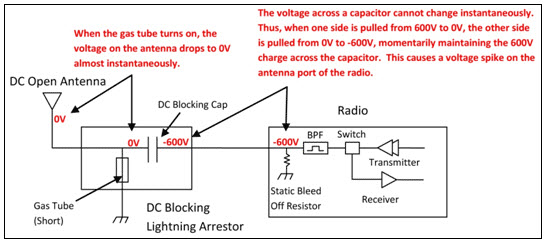Lightning Arrestor
RF engineers and installers have seen many types of radio installations over the years, and they know there are certain details that must not be overlooked at any installation. Most radio installations contain some form of lightning protection. However, the wrong combination of antenna and lightning arrestor can create high voltage transients on the radio’s antenna port having devastating impacts on the life and reliability of modern day radio equipment.
Lightning Arrestor Overview
Lightning arrestors can take many forms. But some of the most common lightning arrestors use gas discharge tubes that turn on when the voltage across their terminals exceeds the specified threshold. Under normal conditions, these devices have a very high impedance and no current flows through the device. When the turn on voltage threshold is exceeded, the gas discharge tube turns on instantaneously and becomes a short.
This functionality works well to limit the magnitude of a transient from a nearby lightening discharge. However, it can have very negative consequences if a gas discharge lightning arrestor is used with the wrong antenna.
Antenna Overview
Antennas can come in just about any shape or size. However, there is one parameter, in particular, that the system designer should not overlook, especially if the radio installation uses gas discharge tube lightning arrestors. The parameter is the DC grounding of the active element in the antenna.
A DC grounded antenna will measure 0 ohms from the active element to ground when tested with an ohm-meter. One way to test this is to connect the ohm-meter from the center conductor to ground of the RF cable that is attached directly to the antenna. This will read as a short for a DC grounded antenna, and as an open for a non DC grounded antenna. Note: Some antenna datasheets are misleading and will indicate the antenna is DC grounded. However, the datasheet may be referring to the body of the antenna and not necessarily the active element. For this reason, it is best to measure the antenna you plan to use to verify the active element is DC grounded.
The Wrong Combination
The combination of a DC open antenna and a DC blocked gas discharge tube lightning arrestor creates a situation where static charge can build up slowly on the active element of the antenna. Static charge can be created by wind blowing across the antenna, precipitation hitting the active element, or other environmental causes. As static charge builds up on the antenna’s active element, over a period of minutes or even hours, the DC blocking capacitor inside the lightning arrestor is charged.
Figure 1 Voltage buildup due to static

When the voltage exceeds 600V (the breakdown voltage for PolyPhaser’s IS-B50LN series), the gas discharge tube turns on and the antenna side of the DC blocking capacitor is immediately pulled from 600V to 0V. Since the lighting arrestor’s capacitor was charged to 600V, that charge must dissipate through the radio. As the capacitor discharges, a large negative transient is created on the antenna port of the radio. Positive transients can also be created if the static charge buildup on the antenna has a negative polarity.
Figure 2 Voltage Transient Immediately After the Gas Tube Turns On

During testing, transients were measured on the antenna port of CalAmp’s Viper at voltage levels up to +/-280V. These voltage transients often have high frequency content that can easily pass through any filtering in the radio and damage components in the transmitter and receiver circuitry.
Good Design Practices
There are two relatively easy ways to avoid creating large transients due to static buildup on an antenna and the subsequent firing of the gas discharge tube in the lightning arrestor. Following either or both of the recommendations below will eliminate this potential problem.
1. Use antennas with a DC grounded active element. Antennas can easily be tested, by using an ohm meter, to measure the resistance from the center conductor to the ground of the RF cable that is directly attached to the antenna. The ohm-meter should indicate a short. (Some antenna designs, such as folded dipole or folded dipole Yagi antennas, inherently have a DC ground on the active element due to the nature of the antenna design.)
2. Use a lightning arrestor that does not have a gas discharge tube. PolyPhaser makes several DC blocked lightning arrestors that have an inductor to ground instead of a gas tube. These lightning arrestors will not allow the static to build up on the antenna, and there is no gas tube that can trigger causing a transient into the antenna port of the radio. The following lightning arrestors, manufactured by PolyPhaser, have inductors to ground instead of gas tubes:
a PolyPhaser Part Number: VHF50HN Frequency Range: 100MHz - 512MHz, 750W
b PolyPhaser Part Number: DSXL Frequency Range: 700MHz - 2.7GHz, 750W
Tip: Lightning arrestors that use gas tubes will normally specify a “Turn On Voltage” in the data sheet. If you see this specification in the datasheet, it is very likely that the lightning arrestor has a gas discharge tube. If you are still unsure, contact the manufacturer.


